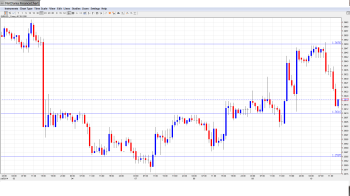EUR/USD is slightly lower on Thursday, as the pair trades in the mid-1.36 range late in the European session. On the release front, French and Italian Industrial Production both posted sharp declines. Today’s highlight in the US is Unemployment Claims, with little change expected from the previous release.
Here is a quick update on what’s moving the pair.
- EUR/USD was flat in the Asian session, and has posted slight losses in the European session.
- Current range: 1.3610 to 1.3650.
Further levels in both directions:
- Below: 1.3610, 1.3585, 1.3550, 1.35, 1.3450, and 1.34.
- Above: 1.3650, 1.3677, 1.37 and 1.3740.
- On the downside, the pair is testing 1.310. 1.3585 follows.
- 1.3650 is weak resistance. 1.3677 is next.
EUR/USD Fundamentals
- 6:45 French Industrial Production. Estimate 0.5%, actual -1.7%.
- 6:45 French CPI. Estimate 0.2%, actual 0.0%.
- 8:00 ECB Monthly Bulletin.
- 8:00 Italian Industrial Production. Estimate 0.6%. actual -1.2%.
- 12:30 US Unemployment Claims. Estimate 316K. See how to trade this event with EUR/USD.
- 14:00 US Wholesale Inventories. Estimate 0.6%.
- 14:30 US Natural Gas Storage. Estimate 92B.
- 17:01 30-year Bond Auction.
- 20:30 US FOMC Member Stanley Fischer Speaks.
*All times are GMT.
For more events and lines, see the Euro to dollar forecast.
EUR/USD Sentiment
- Fed mum on interest rates: The Federal Reserve minutes did not shed much light on when the Fed plans to raise interest rates, but policymakers did agree to wind up the QE scheme by October. The asset purchase program flooded the economy with over $2 trillion, and the Fed has been steadily reducing the program since last December. Winding down QE will require several more tapers by the Fed, but that shouldn’t pose a problem, given the solid employment data the economy has been churning out. EUR/USD did not show much response to the low-key minutes, with the euro posting slight gains on Wednesday.
- German trade surplus widens: There was finally some positive news out of Germany, after a rash of weak data from the Eurozone’s largest economy. Trade Balance improved last month, posting a surplus of EUR 18 billion, the highest reading since last October. This easily surpassed the estimate of EUR 15.7 billion. German retail sales, employment and manufacturing data softened in May, causing concern that a weakening German economy could dash hopes of growth in the Eurozone and hurt the euro.
- US job numbers keep rolling: US employment numbers continue to improve. On Tuesday, JOLTS Job Openings jumped to 4.64 million, easily beating the estimate of 4.53 million. This follows excellent figures from Nonfarm Payrolls and Unemployment Rate. Nonfarm Payrolls, one of the most important indicators, bounced back in June with a strong gain of 288 thousand new jobs. This crushed the estimate of 214 thousand. There was more good news from the Unemployment Rate, which continues to move downward. The indicator dipped to 6.1%, its lowest level since September 2008. The strong employment numbers are sure to increase speculation about an interest rate hike by the Federal Reserve, and remarks by Fed policymakers will be under the market microscope.
- Euro manufacturing data disappoints: Eurozone growth continues to stumble, and there was no relief from Thursday’s manufacturing numbers. Italian Industrial Production came in at -1.2%, compared to the estimate of +0.6%. This was the worst showing since October 2012. French Industrial Production looked even worse, posting a decline of 1.7%. The markets had expected a respectable gain of 0.5%.

